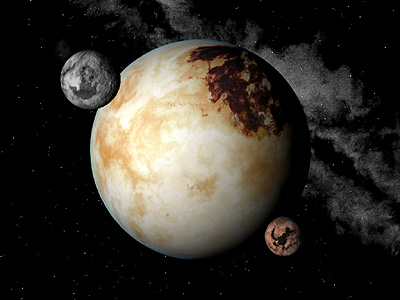Article/Document:
More Planets
Gordon Creighton, Flying Saucer Review, Volume 45/4, Winter 2000
original source | fair use notice
Summary: In FSR 45/2 mention was made of recently discovered planets outside of our own Solar System. In May of this year European astronomers using the European astronomers using the European Southern Observatory (ESO) at La Silla (Chile) announced the finding of eight more "probables" orbiting around other stars in our Galaxy, *thus taking the total so far to 43*.
I. EXTERNAL
In FSR 45/2 mention was made of recently discovered planets
outside of our own Solar System. In May of this year European
astronomers using the European astronomers using the European
Southern Observatory (ESO) at La Silla (Chile) announced the
finding of eight more "probables" orbiting around other stars in
our Galaxy, *thus taking the total so far to 43*. [For full
information please see the website of the ESO:
http://www.eso.org/outreach/press-rel/pr-2000/pr-13-00.html
One of them, around a star in the Constellation of Scutum,
appeared to have about 80% of the mass of our Saturn, and also
to be one of the smallest of these newly found planets. Two
others, a bit bigger than Saturn, were found orbiting around
star No. HD83443 in the Constellation of Vela, and around star
No. HD 108147 in the Constellation of Crux.
Three others are considerably larger. One of them, orbiting
around star No. HD 52265, in the Constellation of Monoceros,
appears to be about the same size as our Jupiter. Another,
around star No. 82943 in the Constellation of Hydra is 2.2 times
the size of Jupiter, while one more, orbiting around star
169830, in the Constellation of Sagittarius, is almost three
times the size of Jupiter!
I recall the very interesting work, in the early 1950s, of the
American astronomer [Frank] Drake, who claimed to have found
evidence that about 50% of the stars in our own Galaxy were
spinning at far greater speeds than the other 50%. And this, he
theorized, might be explicable by the fact that older stars
would, in the natural course of their evolution, have developed
little families of planets which would inevitably act as
"brakes" and slow them down. Does it all indicate that this
pioneer, Drake, was right in his theorizing?
II. "DOMESTIC" In October 1999 there was excitement over reports
that two different astronomical research teams had stated that
they have evidence which seems to confirm the old tales or
rumours of an enormous new "planet-like-body" lying far beyond
the orbit of Pluto and possibly orbiting our Solar System at a
distance of 3 trillion miles (half a light year).
Discussing this, Dr. John Murray of the British Open University
says he has been studying incoming comets which seem to have
been ejected from the extremely remote Oort Cloud by some
powerful gravitational force.
He has analysed 13 of these comets in detail and he says: "I
feel the effect is pretty conclusive. I have calculated that
there is only about a one in 1,700 chance that this is in fact
'all due to chance'!"
In his report to the Royal Astronomical Society he suggested
that this so-far unseen great planet is "several times the size
of Jupiter". And he says a queer thing about it is that it seems
to be orbiting our Sun "in the wrong direction - contrary to the
orbit of all known planets.
This could mean that the huge object may be a so-called 'rogue
planet' that has drifted in from very Deep Space and has been
captured by the gravity of our Sun!"
Physicists John Matese, Daniel Whitmire and Patrick Whitman, all
of the University of Louisiana (Lafayette), have separately
arrived at similar conclusions, and their findings are to be
published in a future issue of *Icarus*.
In his own part of the study Dr. John Matese says the new
arrival may be a "*brown dwarf*", and he estimates its mass at
three times that of Jupiter.
G.C.
Read more articles on this topic:






